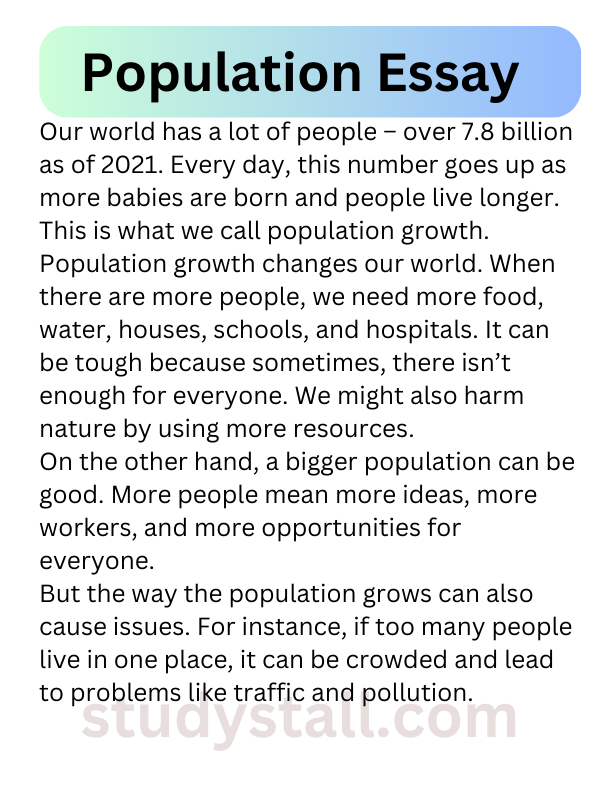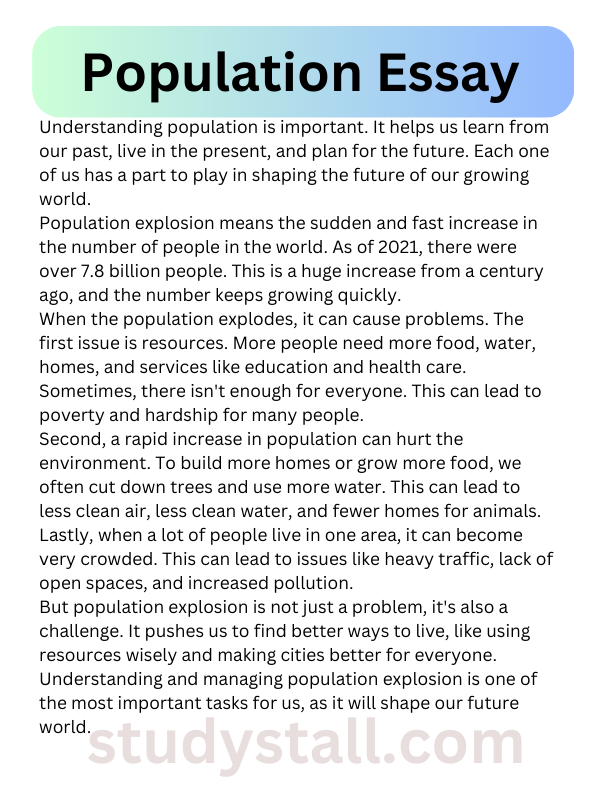Think of population as the total number of people on a team. Just like each team member plays a different role, each person in a population has their own story and impact on the world.
Population doesn’t just talk about how many people there are, but also where they live, how old they are, and how they live their lives.
The number of people living in an area can change many things. It can decide how many schools, hospitals, or houses are needed.
It can also affect things like how much food and water we need, and how much space and nature we have. At the same time, things like how many babies are born, how long people live, and if people move in or out can change the population.
Population Essay In English 150 Words
Our world has a lot of people – over 7.8 billion as of 2021. Every day, this number goes up as more babies are born and people live longer. This is what we call population growth.

Population growth changes our world. When there are more people, we need more food, water, houses, schools, and hospitals. It can be tough because sometimes, there isn’t enough for everyone. We might also harm nature by using more resources.
On the other hand, a bigger population can be good. More people mean more ideas, more workers, and more opportunities for everyone.
But the way the population grows can also cause issues. For instance, if too many people live in one place, it can be crowded and lead to problems like traffic and pollution.
Population Essay 200 Words
Understanding population is important. It helps us learn from our past, live in the present, and plan for the future. Each one of us has a part to play in shaping the future of our growing world.

Population explosion means the sudden and fast increase in the number of people in the world. As of 2021, there were over 7.8 billion people. This is a huge increase from a century ago, and the number keeps growing quickly.
When the population explodes, it can cause problems. The first issue is resources. More people need more food, water, homes, and services like education and health care. Sometimes, there isn’t enough for everyone. This can lead to poverty and hardship for many people.
Second, a rapid increase in population can hurt the environment. To build more homes or grow more food, we often cut down trees and use more water. This can lead to less clean air, less clean water, and fewer homes for animals.
Lastly, when a lot of people live in one area, it can become very crowded. This can lead to issues like heavy traffic, lack of open spaces, and increased pollution.
But population explosion is not just a problem, it’s also a challenge. It pushes us to find better ways to live, like using resources wisely and making cities better for everyone. Understanding and managing population explosion is one of the most important tasks for us, as it will shape our future world.
Population of india essay
India, known for its rich culture and history, is also known for its large population. As of my last knowledge update in 2021, India had over 1.3 billion people, making it the second most populated country in the world, after China.
India’s large population is both a strength and a challenge. On one hand, it gives India a lot of young people who can work and contribute to the country’s growth. This is sometimes called a ‘demographic dividend’, which means India has many people in their working years, which can boost the economy.
On the other hand, having so many people can also create problems. For instance, it can be hard to make sure everyone has enough to eat, a good education, and proper healthcare. It can also mean that jobs are harder to find because there are so many people looking for work.
Another problem can be the strain on the environment. More people means more resources are used, and this can lead to issues like pollution and deforestation.
However, India has been working to tackle these challenges. The government has programs for things like improving education, healthcare, and creating jobs.
Understanding India’s population helps us to understand India better. It tells us about the country’s past, its present challenges, and its potential for the future.
